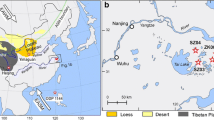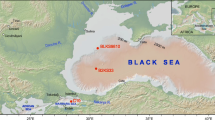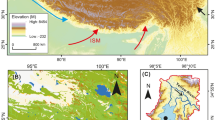Abstract
This paper presents the pollen record from the lower section of ODP1144 (depth 501.3–225.7 m, ca. 1.05–0.36 Ma). Two pollen zones (PA and PB) and eleven pollen subzones are recognized. Within zone PB, the 11 pollen subzones (PB21-11) are defined according to the pine, fern and herb variations, and are equivalent to the marine isotope stages 21–11 (MISs 21–11). The interglacial periods are typified by an increase in pine pollen and fern spores, and a decrease in herbaceous pollen, while the patterning during the glacial periods is just the opposite. During the interglacial periods, pollen assemblages were dominated by pine similar to those of the present day, suggesting that the paleoenvironment of the interglacial periods was similar to that of the present day, whereas the glacial periods are marked by an increase in herbaceous pollen, mainly Gramineae and Cyperaceae, indicating that grassland covered the exposed continental shelf when sea level declined. IncreasedArtemisia percentages and the highest pine influx during MIS12 may result from a stronger winter monsoon.
Similar content being viewed by others
References
Heusser, J., Heusser, L. E., Long continental pollen sequence from Washington State (U.S.A.): Correlation of upper levels with marine pollen—oxygen isotope stratigraphy through substage 5e, Palaeogeography, Palaeoclimatology, Palaeoecology, 1990, 79:63–71.
Heusser, L. E., van de Geer, G, Direct correlation of terrestrial and marine palaeoclimatic records from four glacial-interglacial cycles—DSDP site 594 southwest Pacific, Quaternary Science Reviews, 1994, 13: 273–282.
Heusser, L. E., Lyle, M., Mix, A., Vegetation and climate of the northwest coast of northern America during the last 500 ky: High-resolution pollen evidence from the northern California margin, in Proceedings of the Ocean Drilling Program (eds. Lyle, M, Koizumi, I, Richte, et al.), Scientific Results, 2000, 167: 217–226.
Hooghiemstra, H., Vegetational and climatic history of the high plain of Bogota, Colombia: A continous record of the last 3.5 million years, Dissertactioes Botanicae, 1984, 79: 1–368.
Hooghiemstra, H., Agwu, C, Changes in the vegetation and trade winds in equatorial northwest Africa 140000-70000 yrB.P. as deduced from two marine pollen records, Palaeogeography, Palaeoclimatology, Palaeoecology, 1988, 66: 173–213.
Wang, X., van der Kaars, S., Kershaw, P. et al., A record of fire, vegetation and climate through the last three glacial cycles from Lombok Ridge core G6-4, eastern Indian Ocean, Indonesia, Palaeogeography, Palaeoclimatology, Palaeoecology, 1999, 147: 241–256.
Zheng, Z., Lei, Z. Q., A400000 year record of vegetational and climatic changes from a volcanic basin, Leizhou Peninsula, South China, Palaegeography, Palaeoclimatology, Palaeoecology, 1999, 145: 339–362.
Sun, X. J., Luo, Y. L., Pollen record of the last 280 ka from deep-sea sediments of the northern South China Sea,Science in China, Ser. D, 2001, 44(10): 779–888.
Wang, P. X., Prell, W. L., Blum, P. et al., Proc. ODP Init. Repts., 184 College Station TX (Ocean Drilling Program), 2000, 1–77.
Sun, X. J., Li, X., The differences of modern pollen transport mechanism and distribution pattern between the northern and southern South China Sea, Science in China, Ser. D (in Chinese), 1997, 27(6): 494–198.
Sinnott, E. W., The morphology of the reproductive structure in the Podocarpaceae, Ann. Bot., 1913, 27: 39–82.
Keng, H., On the family Phyllocladaceae, Taiwania, 1973, 18: 142–145.
Keng, H., Anew scheme of classification of the conifers, Taxon, 1975, 24(2/3): 289–292.
Sse, H. C, Li, X. X., Li, P. J. et al., ChinaPlants Fossils (Vol. 2): Mesozoic Plants From China (in Chinese), Beijing: Science Press, 1963, 127–362.
Wu, Z. Y., Vegetation of China (in Chinese), Beijing: Science Press, 1995, 889–896.
Huang, W., Vegetation of Taiwan (in Chinese), Beijing: China Environmental Science Press, 1993, 1–279.
Sun, X. J., Li, X., Beug, H-J., Pollen distribution in hemipelagic surface sediments of the South China Sea and its relation to modern vegetation distribution, Marine Geology, 1999, 156: 211–226.
Florin, R., The distribution of conifer and taxad genera in time and space, Acta Horti Bergianizo, 1963, (4): 121–312.
Huang, F., Charcoal record and natural fire history during 1.02-0.36 Ma in northern South China Sea, Acta Micropalaeontologica Sinica (in Chinese), 2002, 19(1): 76–82.
Author information
Authors and Affiliations
Corresponding author
Rights and permissions
About this article
Cite this article
Fei, H., Xiangjun, S. Palynological record during the Pleistocene (between 1.05 Ma and 0.36 Ma) from ODP1144, northern South China Sea. Sci. China Ser. D-Earth Sci. 47, 30–36 (2004). https://doi.org/10.1007/BF03028860
Received:
Revised:
Issue Date:
DOI: https://doi.org/10.1007/BF03028860




